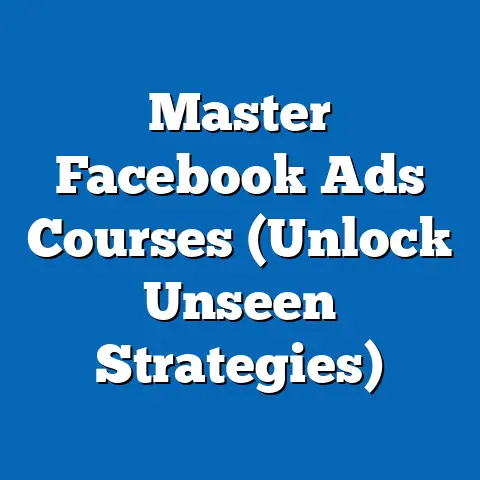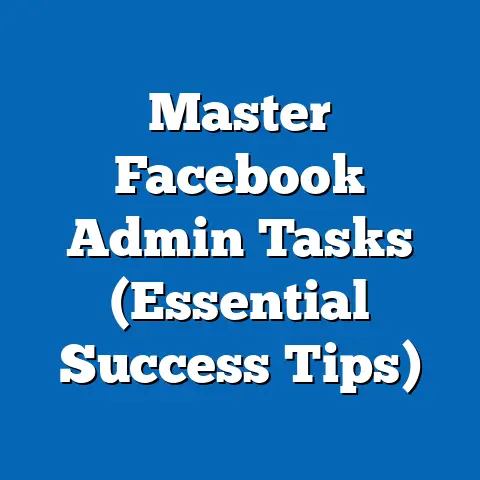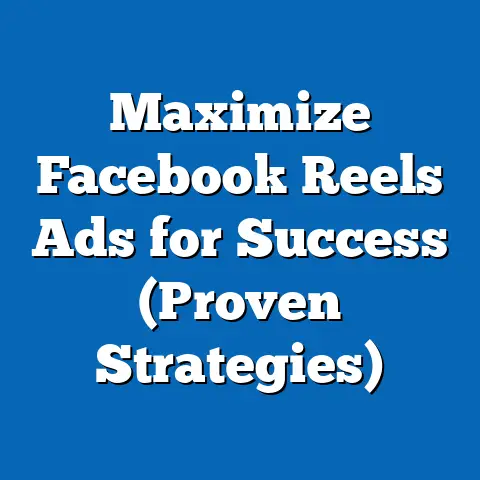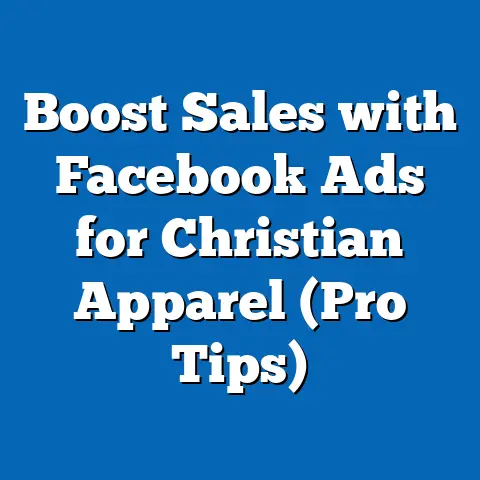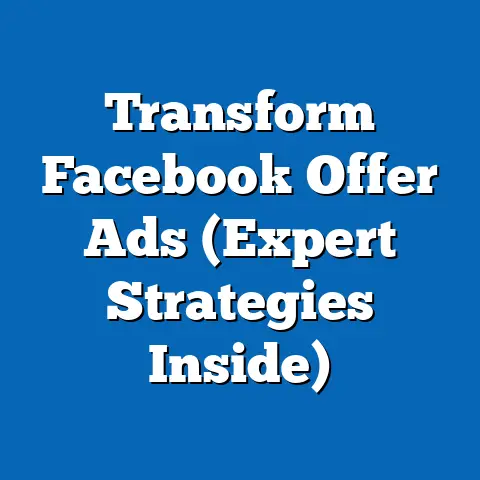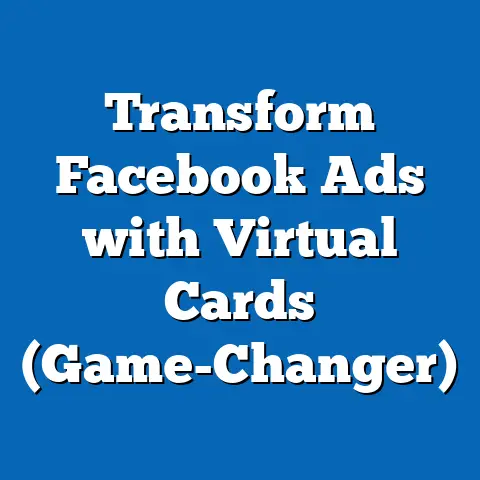Unlock Winning Facebook Auto Ads (Proven Strategies Inside)
Imagine tending to a garden. You carefully select your seeds, nurture the soil, and watch patiently as life sprouts and blossoms. Running Facebook Auto Ads can feel similar. It’s about planting the right seeds (your ads), nurturing them with data, and watching your campaign grow into something beautiful. Just as a gardener tailors their approach to the specific plants they’re growing, successful advertisers personalize their campaigns to resonate with specific audiences.
I’ve spent years helping businesses navigate the ever-changing landscape of Facebook advertising, and I’ve seen firsthand the power of Auto Ads when used strategically. They’re not a magic bullet, but when combined with a deep understanding of your audience, they can be incredibly effective. In this guide, I’ll share proven strategies to help you unlock the winning potential of Facebook Auto Ads, focusing on connecting with niche audiences through their passions and hobbies. Think of it as your comprehensive toolkit to turn those clicks into conversions.
Understanding Facebook Auto Ads
Facebook Auto Ads are, at their core, automated advertising campaigns designed to simplify the ad creation and optimization process. Instead of manually tweaking every setting, you provide Facebook with some basic information – your objective, budget, and target audience – and its algorithms take over, automatically optimizing your ads for performance. This leverages machine learning to identify the most effective ad placements, targeting parameters, and creative variations. It’s like having a team of data scientists working behind the scenes to fine-tune your campaign 24/7.
The Benefits of Automation
The biggest advantage of Auto Ads is the significant time savings they offer. For small businesses or individuals juggling multiple tasks, the ability to delegate ad optimization to Facebook’s algorithms can be a game-changer. This allows you to focus on other critical aspects of your business, like product development or customer service.
Beyond time savings, Auto Ads can also help you reach a broader audience. The algorithms are designed to identify potential customers you might not have considered through manual targeting. This can lead to increased brand awareness and new customer acquisition.
From my experience, the ease of use makes Auto Ads a great starting point, especially for beginners. It allows you to get your feet wet without feeling overwhelmed by the complexity of the Ads Manager. However, don’t be fooled by the simplicity; understanding the underlying principles is crucial for achieving optimal results.
Types of Auto Ads on Facebook
Facebook offers a variety of Auto Ad formats, each designed for specific purposes. Understanding these formats is key to choosing the right one for your campaign goals. Here are a few key formats:
- Dynamic Ads: These ads automatically promote relevant products to people who have expressed interest on your website, in your app, or elsewhere on the internet. For example, if someone browses gardening tools on your website, dynamic ads can retarget them with specific products they viewed.
- Collection Ads: These visually immersive ad formats showcase a collection of products or services. They’re perfect for hobby-related businesses that want to highlight a range of offerings, like different types of knitting yarn or various photography lenses.
- Lead Ads: Designed to generate leads directly on Facebook, these ads make it easy for people to sign up for newsletters, request quotes, or download resources. This can be particularly effective for offering free guides or tutorials related to popular hobbies.
- App Install Ads: If you have an app related to a particular hobby (e.g., a recipe app for cooking enthusiasts), these ads are designed to drive downloads.
Takeaway: Facebook Auto Ads simplify advertising, save time, and can broaden your reach. Understanding the different types available is crucial for selecting the right format for your objectives.
Crafting Your Ad Strategy
While Facebook’s algorithms handle the optimization, you still need a solid strategy to guide your Auto Ads. This involves defining your objectives, understanding your target audience, and crafting compelling ad creative.
Defining Your Objectives
Before launching any ad campaign, it’s crucial to define what you want to achieve. Are you looking to increase brand awareness, generate leads, or drive sales? Your objective will influence every aspect of your campaign, from targeting to ad creative.
For example, if you’re selling photography equipment, your objective might be to drive sales of a new camera lens. In this case, your ad creative would focus on the lens’s features and benefits, and your targeting would focus on photographers who are likely to be interested in upgrading their equipment.
Here are some common advertising goals and how they relate to hobbies:
- Brand Awareness: Introduce your brand to a wider audience of hobbyists.
- Lead Generation: Collect contact information from interested individuals (e.g., sign-ups for a cooking class).
- Website Traffic: Drive traffic to your website to showcase products or services related to a specific hobby.
- Sales Conversion: Directly sell products or services to hobbyists (e.g., gardening supplies, art supplies).
Identifying Your Target Audience
Understanding your target audience is paramount. Who are you trying to reach with your ads? What are their interests, demographics, and behaviors? Facebook offers powerful audience insights tools that can help you answer these questions.
For example, let’s say you’re selling gourmet coffee beans. You could target people who have expressed interest in coffee, specialty foods, or home brewing. You could also target people who have liked pages related to coffee shops or coffee brands.
Here’s how you can use Facebook’s audience insights tools:
- Facebook Audience Insights: This tool provides detailed demographic and interest data about Facebook users. You can use it to identify the interests, behaviors, and demographics of people who are interested in specific hobbies.
- Facebook Pixel: By installing the Facebook Pixel on your website, you can track the actions that people take on your site after clicking on your ads. This data can be used to refine your targeting and optimize your campaigns.
- Customer Lists: You can upload customer lists to Facebook and create custom audiences based on your existing customers. This is a great way to retarget people who have already purchased from you or engaged with your brand.
Creating detailed buyer personas can also be helpful. A buyer persona is a fictional representation of your ideal customer. It includes information like their age, gender, occupation, interests, and motivations. By creating buyer personas, you can better understand your target audience and create ads that resonate with them.
Selecting the Right Visuals and Copy
Your ad creative is what will ultimately capture the attention of your target audience. It’s crucial to select visuals and copy that are relevant, engaging, and visually appealing.
Here are some tips for selecting the right visuals:
- Use high-quality images and videos: Blurry or pixelated images will turn people off.
- Showcase your products or services in action: If you’re selling gardening supplies, show people using them to grow beautiful gardens.
- Use images and videos that are relevant to your target audience: If you’re targeting photographers, use images that showcase stunning photography.
- Consider using user-generated content: Testimonials and photos from satisfied customers can be incredibly persuasive.
Here are some tips for writing compelling ad copy:
- Highlight the benefits of your products or services: What problem do they solve? How will they improve people’s lives?
- Use a clear and concise call to action: Tell people exactly what you want them to do (e.g., “Shop Now,” “Learn More,” “Sign Up”).
- Use strong verbs and persuasive language: Create a sense of urgency and excitement.
- Personalize your ad copy: Address your target audience directly and speak to their specific interests and needs.
Storytelling is also a powerful tool for connecting with your audience. Tell a story about how your products or services have helped other hobbyists. Share testimonials from satisfied customers. Create a narrative that resonates with your target audience and makes them feel like they’re part of something special.
Takeaway: Define your objectives, understand your target audience using Facebook’s tools, and craft compelling ad creative that resonates with their interests and passions.
Proven Strategies for Success
Now that you have a solid foundation, let’s dive into some proven strategies for maximizing the effectiveness of your Facebook Auto Ads.
A/B Testing: The Key to Optimization
A/B testing, also known as split testing, is the process of comparing two versions of an ad to see which performs better. This is an essential strategy for optimizing your Auto Ads and ensuring that you’re getting the most bang for your buck.
Here’s how to conduct A/B tests:
- Create two versions of your ad: Change one element at a time (e.g., headline, image, call to action).
- Run both ads simultaneously: Make sure they’re targeting the same audience.
- Track the results: Monitor key metrics like click-through rate (CTR) and conversion rate.
- Identify the winner: The ad with the higher CTR or conversion rate is the winner.
- Repeat the process: Continue testing different elements to further optimize your ads.
For example, you could test two different headlines for your gardening supply ad:
- Headline A: “Grow the Garden of Your Dreams with Our High-Quality Supplies”
- Headline B: “Get Everything You Need to Create a Thriving Garden Today”
By testing these two headlines, you can determine which one resonates better with your target audience and drives more clicks and conversions.
Retargeting Campaigns: Reaching Engaged Users
Retargeting is the process of showing ads to people who have already interacted with your brand. This is a highly effective strategy because these people are already familiar with your brand and are more likely to convert.
Here’s how to create retargeting campaigns:
- Install the Facebook Pixel on your website: This will allow you to track the actions that people take on your site.
- Create custom audiences based on website visitors: Target people who have visited specific pages on your website (e.g., product pages, blog posts).
- Create retargeting ads that address their specific interests: Show them ads for the products or services that they viewed on your website.
For example, if someone visited a product page for a specific type of knitting needle on your website, you could retarget them with an ad that highlights the features and benefits of that needle. You could also offer them a special discount to incentivize them to purchase.
Utilizing User-Generated Content: Building Trust and Credibility
User-generated content (UGC) is any content that has been created by your customers. This can include testimonials, photos, videos, and social media posts. UGC is a powerful tool for building trust and credibility because it comes directly from your customers.
Here’s how to utilize UGC in your Facebook Auto Ads:
- Ask your customers for testimonials: Encourage them to share their experiences with your products or services.
- Run contests and giveaways: Encourage people to submit photos or videos of themselves using your products or services.
- Feature UGC in your ads: Show real people using your products or services and sharing their positive experiences.
For example, if you’re selling cooking supplies, you could feature photos of your customers’ delicious creations in your ads. You could also share testimonials from satisfied customers who have used your products to create amazing meals.
Leveraging Seasonal Trends: Staying Relevant
Many hobbies are seasonal in nature. Gardening is popular in the spring and summer, while cooking is more popular during the holidays. By adjusting your ad strategies to align with seasonal trends, you can increase your relevance and improve your results.
Here are some tips for leveraging seasonal trends:
- Create ads that are relevant to the current season: Promote gardening supplies in the spring and summer, and cooking supplies during the holidays.
- Offer seasonal discounts and promotions: Encourage people to purchase your products or services during peak seasons.
- Create content that is relevant to the current season: Share gardening tips in the spring and summer, and holiday recipes during the holidays.
Takeaway: A/B testing, retargeting, user-generated content, and leveraging seasonal trends are all proven strategies for maximizing the effectiveness of your Facebook Auto Ads.
Analyzing and Optimizing Your Campaigns
Monitoring your ad performance is crucial for identifying areas for improvement and ensuring that you’re getting the most out of your budget. Facebook Ads Manager provides a wealth of data that you can use to analyze your campaigns and make informed decisions.
Key Performance Metrics to Track
Here are some key performance metrics to track:
- Reach: The number of people who saw your ad.
- Impressions: The number of times your ad was displayed.
- Click-Through Rate (CTR): The percentage of people who clicked on your ad after seeing it.
- Conversion Rate: The percentage of people who took a desired action (e.g., made a purchase, signed up for a newsletter) after clicking on your ad.
- Cost Per Click (CPC): The average cost you paid for each click on your ad.
- Cost Per Conversion (CPC): The average cost you paid for each conversion.
- Return on Ad Spend (ROAS): The amount of revenue you generated for every dollar you spent on advertising.
Analyzing Data and Making Informed Decisions
By monitoring these metrics, you can identify areas where your campaigns are performing well and areas where they need improvement. For example, if your CTR is low, it might indicate that your ad creative isn’t resonating with your target audience. If your conversion rate is low, it might indicate that your landing page isn’t optimized for conversions.
Here are some tips for analyzing data and making informed decisions:
- Set benchmarks for each metric: Determine what a good CTR, conversion rate, and ROAS are for your industry and business.
- Track your metrics over time: Monitor how your metrics change over time and identify any trends.
- Compare your metrics to your benchmarks: Identify areas where your campaigns are falling short of your goals.
- Experiment with different strategies: Test different ad creative, targeting parameters, and bidding strategies to see what works best.
- Continuously optimize your campaigns: Make adjustments to your campaigns based on the data you’re collecting.
Takeaway: Monitor your ad performance using Facebook Ads Manager, track key performance metrics, and analyze the data to make informed decisions about how to optimize your campaigns.
Conclusion
Facebook Auto Ads offer a powerful way to connect with niche audiences through their hobbies and passions. By understanding the basics of Auto Ads, crafting a solid strategy, and implementing proven tactics, you can unlock the winning potential of this advertising platform.
Remember, success in advertising, like in any hobby, requires dedication, creativity, and a willingness to learn from experience. Don’t be afraid to experiment with different strategies and see what works best for your business.
Now it’s your turn. Start crafting your winning Facebook Auto Ads and share your success stories in your favorite hobbies! Get started today and watch your business grow.

